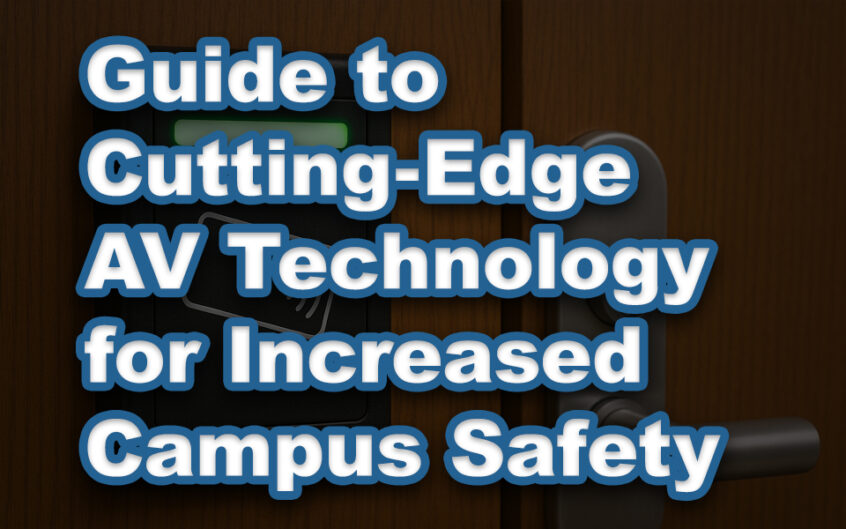As a facilities manager in higher education, ensuring the safety of your campus is more than just a job—it’s a calling. The weight of responsibility for protecting students, faculty, and staff is ever-present, driving you to seek out the most effective solutions. With the campus safety technology industry now valued at $2.7 billion, it’s clear that you’re not alone in recognizing the critical importance of this mission.
Recent events have dramatically altered how students perceive and navigate their campus homes. As a result, you may feel an increased urgency to implement robust safety measures that can respond swiftly to various emergencies, from active shooter situations to severe weather events. Let’s explore how cutting-edge audiovisual (AV) technology can help you create a safer campus environment, addressing your concerns and aspirations along the way.
1. Access Control Systems: Your First Line of Defense
Imagine being able to secure your entire campus at the touch of a button. Access control systems make this a reality, allowing you to restrict entry to residence buildings, lecture halls, and administrative areas. These systems significantly reduce the risk of unauthorized access, giving you peace of mind and a sense of control over your campus’s security.
The central monitoring capabilities of these systems are a game-changer. In an emergency, you can lock or unlock doors remotely, providing crucial situational awareness that wasn’t possible before. This level of control can be incredibly reassuring, knowing you can respond quickly to protect your campus community.
2. IP-Enabled Cameras: Eyes Everywhere
Upgrading from traditional analog cameras to IP-enabled cameras is like giving your security team superpowers. These advanced systems offer multiple sensors, motion and smoke detection, people tracking, and alarm triggering capabilities. The improved resolution and coverage area position your campus safety team closer to incidents, capturing crucial details like facial features, clothing descriptions, and license plate numbers.
Imagine the relief of being able to provide law enforcement with clear, detailed footage during an incident. It’s not just about surveillance; it’s about having the tools to make a real difference in keeping your campus safe.
3. Gunfire Detection Systems: Split-Second Response
The history of school shootings is a heavy burden that weighs on every facilities manager’s mind. Gunfire detection systems can provide some solace. These sensors instantly identify the number of shots fired, the type of weapon used, and provide a detailed map of the shooter’s location.
While we hope never to need such systems, having this technology in place can significantly reduce response times and potentially save lives. It’s about being prepared for the worst while hoping for the best.
4. Geographic Information Systems (GIS) and Indoor Positioning Systems (IPS): Precision in Crisis
In an emergency, every second counts. GIS and IPS technologies provide essential spatial context during crises, offering blueprints and 3D imagery of threat areas, real-time location tracking of key resources, and detailed floor plans with highlighted access points.
Imagine the confidence you’ll feel knowing that emergency responders have access to detailed floor plans and 360-degree room views of your campus. This technology doesn’t just improve response times; it gives you the assurance that help will arrive exactly where it’s needed, when it’s needed.
5. Safety Features in Apps: Empowering Your Community
Integrating safety features into campus apps or promoting dedicated safety apps can transform every smartphone on campus into a potential lifeline. These tools offer in-app panic buttons, text-to-911 capabilities, crime reporting mechanisms, and emergency alerts with response guidance.
By providing these tools, you’re not just improving safety; you’re giving your campus community a sense of control and involvement in their own security. It’s about creating a culture of safety where everyone plays a part.
Overcoming Implementation Challenges
While these technologies offer significant benefits, it’s natural to feel some apprehension about their implementation. You might worry about the complexity of installation, the time required for training, or the strain on your budget. These concerns are valid, but remember that the long-term benefits in terms of improved safety and peace of mind for your campus community make it a worthwhile investment.
To ease the transition:
1. Start with a thorough assessment of your specific campus security needs.
2. Involve all stakeholders in the planning process to ensure buy-in and effective utilization.
3. Develop a comprehensive training program to ensure proper use of new systems.
4. Create an implementation timeline that minimizes disruption to academic activities.
5. Establish clear metrics to measure the effectiveness of your new safety technologies.
Looking to the Future
As you implement these technologies, consider how they can be further integrated with other campus systems. Combining security tech data with student information (like emergency contacts or medical conditions) can provide a more comprehensive picture to emergency responders.
Embracing these cutting-edge AV technologies for higher education isn’t just about adopting new tools—it’s about fundamentally transforming the way your campus approaches safety and security. As a facilities manager, you have the power to create a safer, more secure environment for your entire campus community. It’s a big responsibility, but with the right tools and approach, it’s one you’re more than capable of handling.

